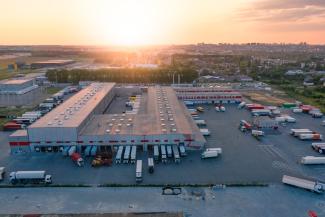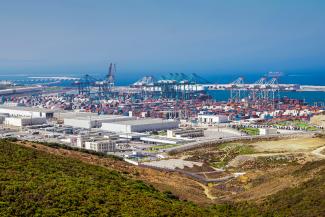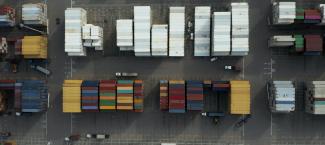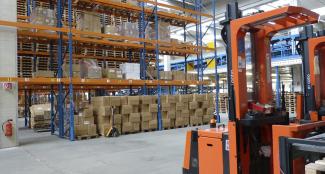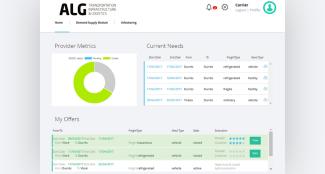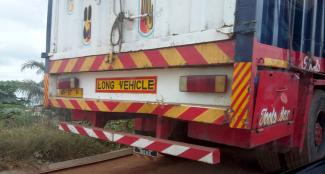Inter-regional trade and intra-regional trade comprise two main dimensions of global trade flows. Inter-regional trade is primarily driven by extensive maritime flows that connect countries and continents, forming the backbone of global commerce, and is complemented by land transport corridors, which play a crucial role in linking landlocked countries to major seaports.
In contrast, intra-regional trade is more geographically concentrated, involving exchanges between neighbouring economies where land-based transportation plays a pivotal role, coexisting with short-sea shipping and feeder services, which together complement regional trade networks.
Although inter-regional accounts for more than 80% of global trade by volume, it is intra-regional trade that generates the highest intensity of land transport and cross-border logistics activity. In many regions, intra-regional trade represents an important share of overall commercial activity, fostering substantial cross-border flows of goods between neighbouring countries, often operating under established trade agreements.

This dynamic demands for efficient and integrated multimodal transport and logistics solutions to support the seamless movement of goods across borders. Unlike the EU Customs Union, where goods circulate freely without the need for internal customs clearance, trade within most regional markets worldwide still relies on physical border crossings that involve physical inspections, customs formalities, and multimodal transfers.
To enhance trade facilitation and improve the efficiency of cross-border operations, the development of logistics zones adjacent to major land ports play a pivotal role. Their proximity to border crossings make such locations natural hubs for regional connectivity and trade optimization.
What are cross-border logistics zones?
In general, logistics zones are designated areas equipped with specialized infrastructure, equipment and services to support logistics operators for traders and cargo owners. These zones typically feature warehouses, storage yards, and handling facilities designed to facilitate the reception, storage, light processing, and dispatch of goods, as well as service areas for vehicles and users.
The strategic advantage of logistics zones lies not only in their efficient connectivity—often located at key nodes within transport networks near highways, rail corridors, ports, or airports—but also in their specialization of facilities, equipment, and services designed to enhance multimodality, optimize storage and transit times, and minimize overall logistics costs.
Logistics zones are commonly characterized along four main dimensions. Together, these dimensions determine the overall effectiveness of a logistics zone as a hub within national and international supply chains. These include:
- Connectivity: Ranging from monomodal platforms, which focus on a single mode of transport (e.g., Prologis Park Hemel Hempstead, UK), to multimodal platforms that integrate two or more transport modes, such as Khorgos Gateway and the International Center for Border Economic Cooperation (ICBEC), which consolidate road and railway transport at the border between China and Kazakhstan.
- Scope of operations: This dimension reflects the functional diversity within logistics zones. It ranges from single-purpose facilities dedicated to specific activities, such as Fresh Park Venlo, which focuses on agri-food logistics, to multi-purpose platforms that integrate a wide array of logistics and value-added services, exemplified by the Jebel Ali Free Zone which consolidates industrial and logistics activity serving all sectors.
- Management structure: This aspect concerns the organizational and governance framework of the zone. It may take the form of a single consolidated site, as seen in the Tanger Med Logistics Zone, or a networked system of sites operating under a unified management framework, such as Aragón Plataforma Logística (APL), which encompasses PLAZA in Zaragoza, PLHUS in Huesca, and PLATEA in Teruel, Spain.
- Commercial structure: This dimension addresses how logistics zones are financially and institutionally structured. Some zones are publicly developed by authorities that invest in the required infrastructure and lease or sell plots to tenants. However, there is a growing trend in the implementation of public–private partnership (PPP) models, in which private developers finance and build key infrastructure, utilities, and assets, operate the site, and manage the leasing of facilities to end users.
In the global context, logistics zones are increasingly being integrated into international trade corridors, where they function as vital platforms for the consolidation and coordination of goods flows. In particular, cross-border logistics zones play a strategic role in alleviating border bottlenecks and facilitating seamless intra-regional trade, enhancing the efficiency and resilience of global supply networks.
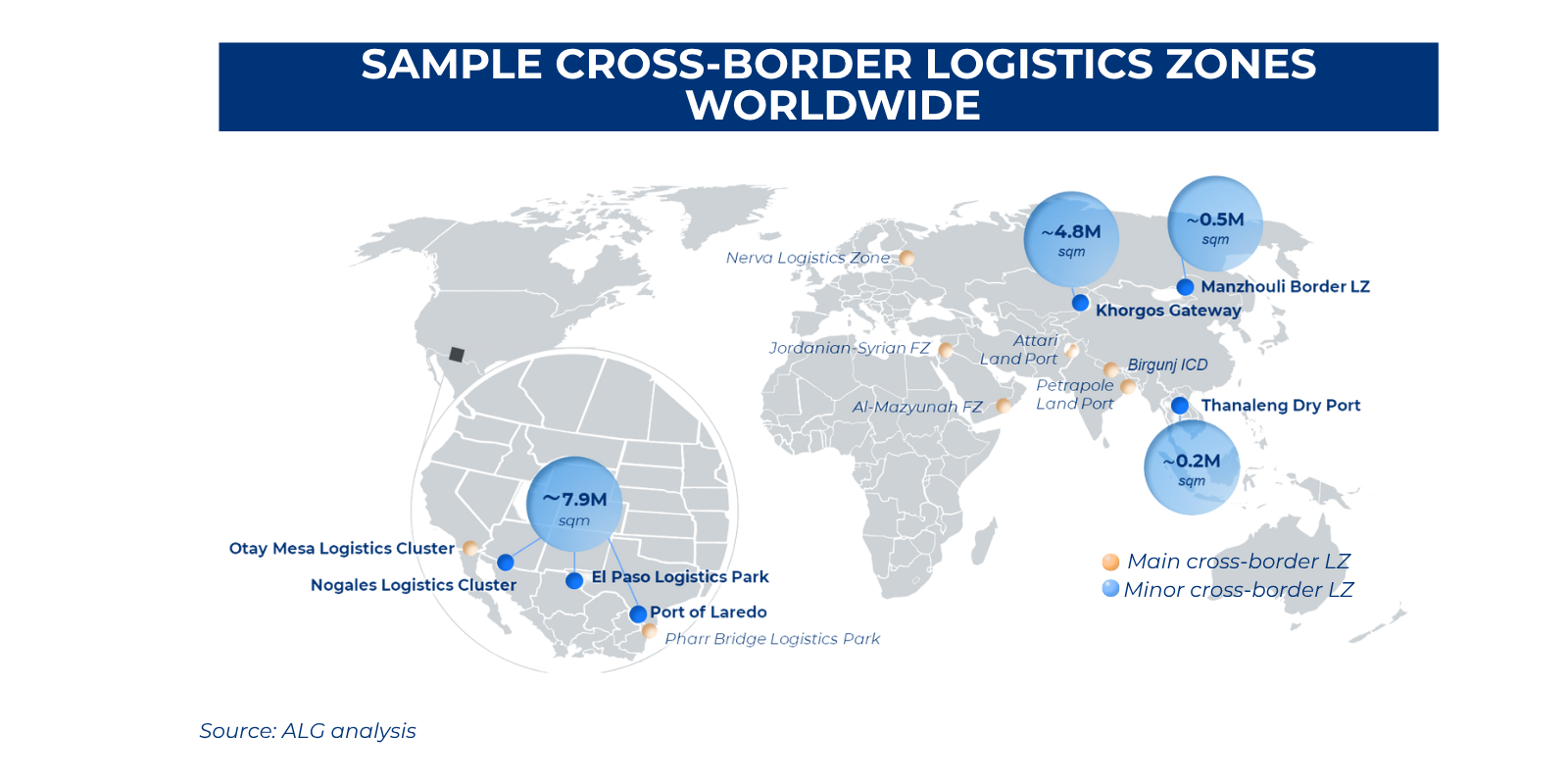
A cross-border logistics zone can thus be defined as a logistics platform strategically developed at or in close proximity to an international border crossing, typically organized as a single consolidated site that provides both multimodal connectivity and multi-purpose facilities. What distinguishes these zones is their frequent allocation of a special customs status, often complemented by targeted incentives designed to attract investment and facilitate the efficient movement of goods across borders.
Such incentives may encompass bonded treatment for customs clearance, tax advantages, and broader regulatory benefits that support value-added logistics and industrial activities. In this context, cross-border logistics zones are situated within the broader typology of logistics areas, which includes non-bonded and bonded zones, free zones, and special economic zones, each characterized by a distinct combination of incentives and regulatory frameworks.

Beyond the regulatory and fiscal dimensions, cross-border logistics zones also contribute significantly to improving operational efficiency of border crossing operations for international trade. Differences in infrastructure standards, vehicle requirements, or customs processes between neighboring countries often need transshipment or cargo reorganization at the border. By concentrating handling, storage, and inspection facilities within a single coordinated platform, these zones enable seamless modal transfers, reduce dwell times, and harmonize logistics procedures, enhancing overall cross-border operations.
This combination of strategic location, multimodal connectivity, tailored services, and efficiency improvements and incentive frameworks positions cross-border logistics zones as pivotal platforms for transforming borders from potential barriers into trade enablers.
Benchmarking and insights
Global best practices demonstrate that the success of cross-border logistics zones is driven by a consistent set of factors. Most competitive platforms integrate a robust institutional framework, high-quality infrastructure, diversified market demand, and effective governance structures. Collectively, these elements enable a zone to transition from its initial establishment to a sustainable role as a strategic node within regional and global trade networks.
Insight 1: Strategic location within regional trade corridors
Cross-border logistics zones derive their competitive advantage from their strategic positioning within the international trade ecosystem, strategically positioned along high-volume corridors to capture scale and sustain demand. Successful platforms position themselves as primary gateways between markets, serving as the default entry and exit points for bilateral trade flows. This relevance is achieved through the integration of bonded facilities, customs inspection services, and value-added operations within a single location, enabling the zone to operate as a comprehensive one-stop gateway for clearance, handling, storage and other logistics processes.
Insight 2: Integrated infrastructure and multimodal connectivity
Securing demand for cross-border logistics zones relies on two main interdependent conditions. First, the consolidation of logistics services—including handling, storage, and customs clearance—is essential to minimize handovers and streamline operations. Second, establishing robust multimodal connectivity, via land, maritime or air transport, is key to expanding the zone’s hinterland and enabling seamless access to both local and regional markets. When these conditions are effectively realized, logistics zones can deliver enhanced efficiency, resilience, and value creation across the broader supply chain.
Insight 3: Diversified customer base, proactive promotion, and stakeholder engagement
Long-term success of a cross-border logistics zone also depends on its ability to attract and retain a diversified customer base. Competitive zones not only align with prevailing trade flows but also strategically position themselves within proximate production and consumption clusters to serve their logistics needs. Serving a broad mix of tenants—such as industrial manufacturers, agricultural exporters, and logistics operators—mitigates exposure to market fluctuations.
To anchor and sustain this demand, successful zones cultivate long-term relationships with tenants, encouraging their investment in facilities aligned with market needs. This is complemented by proactive promotion and public support, ensuring the zone remains attractive and aligned with national trade priorities.
Insight 4: Governance and commercial sustainability
Cross-border logistics zones achieve better performance when their governance foundations are clearly articulated and reinforced through effective public-private collaboration (PPPs). These frameworks offer a key advantage for the adequate development of the cross-border logistics zones, allowing the state to retain strategic oversight while delegating day-to-day management to private operators. Financial viability relies on a clear allocation of risks and costs, with governments often financing major infrastructure and developers investing in operational assets. This is supported by varied service offering—including leasing, logistics services, and value-added activities—that secure stable returns and ensure long-term sustainability.

Socio-economic value of cross-border logistics zones
The benefits of cross-border logistics zones extend beyond improving border operations. These platforms enhance supply chain efficiency, facilitate international trade, and contribute to the reduction of logistics costs. By optimizing the movement of goods across borders, they strengthen a country’s trade competitiveness and support its integration into regional and global markets.
The broader impact of cross-border logistics zones can be evaluated through their effect on a country’s logistics performance, commonly measured by the World Bank’s Logistics Performance Index (LPI). The LPI evaluates the quality of trade and transport systems across six dimensions, with the development of cross-border logistics zones directly contributing to improvements across several of these areas. By consolidating customs and inspection functions within the zone and integrating multimodal connectivity with multi-purpose facilities, these platforms deliver tangible enhancements to a country’s logistics performance.
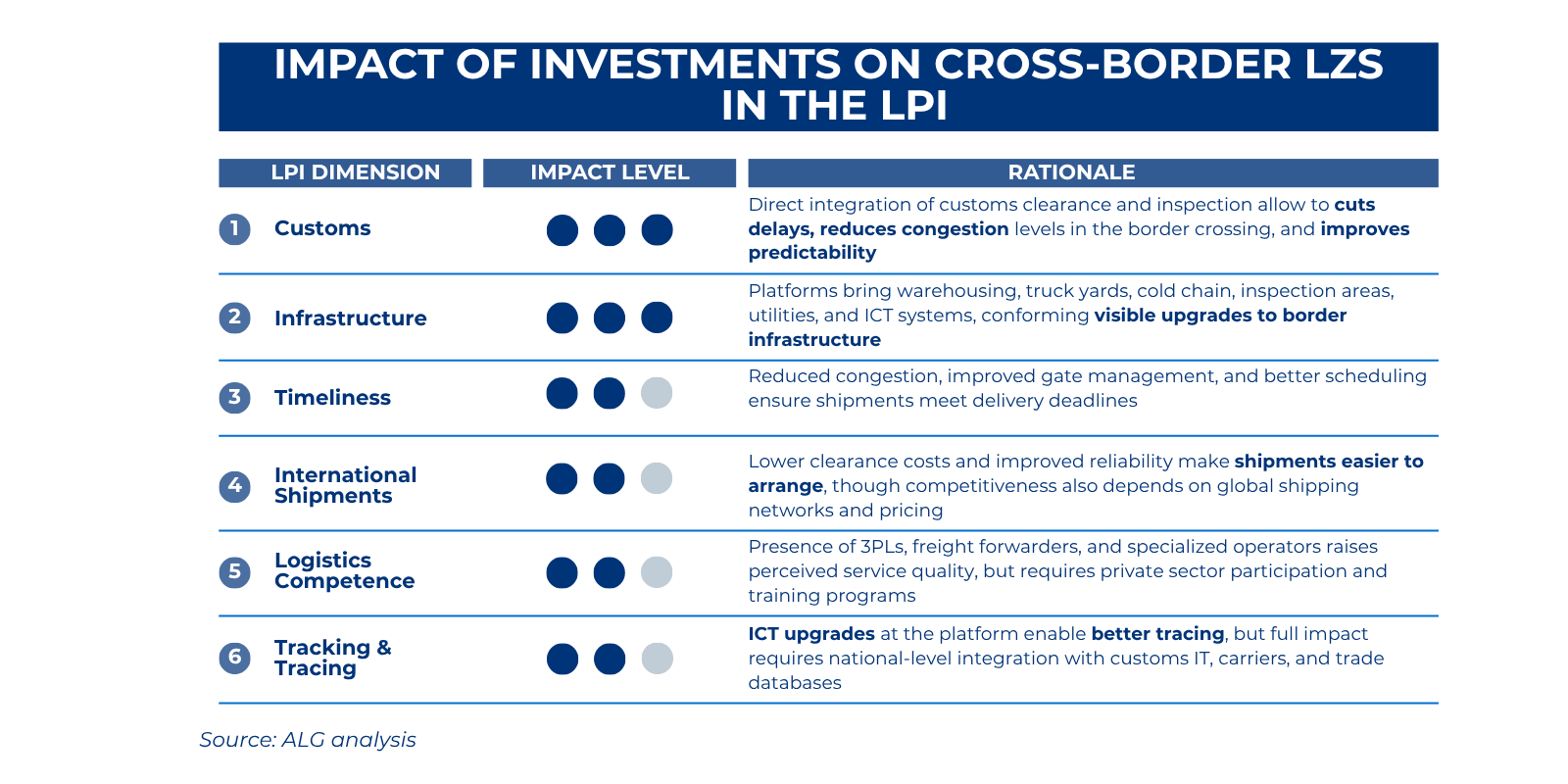
The importance of these improvements is underscored by the historical correlation between LPI scores and GDP per capita, which indicates that countries with higher LPI scores consistently present higher income levels.

Comparative analysis across different LPI ranges indicates that advancement from one band to the next is generally associated with a substantial increase in average GDP per capita (∼2.0x).
Beyond impacts on GDP per capita, cross-border logistics zones generate broader benefits. They create direct and indirect employment opportunities, support higher-quality jobs, enhance export competitiveness, and contribute to fiscal revenues. Simultaneously, they promote social inclusion and advance sustainability objectives by encouraging intermodal transport and reducing emissions.
In developing economies, these platforms can also help formalize informal trade activities by providing a secure and regulated space for small-scale traders—particularly women—to operate safely and access broader markets. This contributes to gender inclusion, income stability, and the gradual integration of informal commerce into formal supply chains.
Commercial perspective
Cross-border logistics zones are complex projects that require the alignment of strategy, financing, and governance to achieve long-term success. From a commercial perspective, these platforms represent highly attractive entry points for private sector involvement, particularly through PPP schemes.

Their business appeal lies in the potential to develop and operate income-generating assets—such as warehouses, value-added facilities or service areas—while contributing to broader national objectives like trade facilitation, job creation, and industrial diversification. For public authorities, PPPs allow mobilizing private capital and operational expertise to accelerate infrastructure delivery and ensure long-term sustainability.
Within this context, ALG has developed extensive expertise in supporting both private companies and public authorities to meet these challenges. Through its experience advising on PPP frameworks and investment structuring, ALG has worked alongside governments and leading logistics operators to design and implement intermodal hubs, industrial parks, and special economic zones.
With experience across 10+ countries and over 10 million square meters of logistics capacity delivered, ALG’s services cover the full project cycle—from strategic definition and feasibility studies to financial modelling, technical design, and transaction support. This combination of international reach and applied project delivery makes ALG a trusted partner in turning cross-border logistics projects into operationally resilient and commercially bankable platforms.


